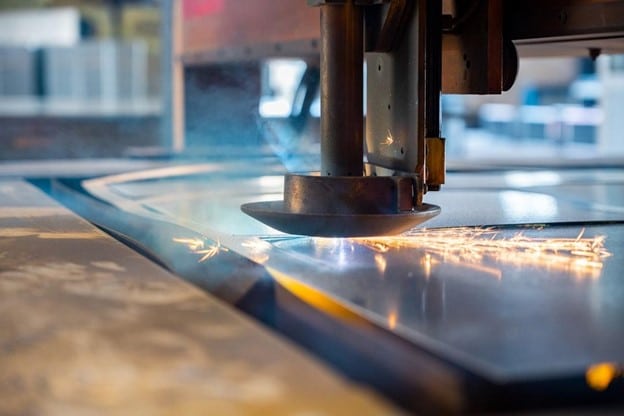- Laser cutting offers eco-friendly benefits, including precision, waste reduction, and energy efficiency.
- It minimizes harmful emissions and supports recycling efforts, aligning with sustainable practices.
- The technology enables innovative, sustainable product designs, such as lightweight structures.
- Advances in laser cutting technology continue to enhance its efficiency and environmental benefits.
In today’s world, where environmental concerns are more pressing than ever, the demand for sustainable manufacturing practices is growing. One technology that’s making a significant impact in this arena is laser cutting. Known for its precision and efficiency, laser cutting is not only a versatile tool in metal fabrication but also a key player in promoting eco-friendly practices. This blog will explore the sustainable benefits of laser cutting, from reducing waste to enabling the use of greener materials, and how it can help create a more sustainable future.
What is Laser Cutting?
Laser cutting is a technology that uses a high-powered laser beam to cut, engrave, or mark materials with exceptional precision. In metal fabrication, laser cutting is employed to create intricate designs and accurate dimensions, making it a go-to method for a variety of industries, including automotive, aerospace, and architecture. The process involves directing the laser beam through optics, which focuses the beam onto the material’s surface, melting or vaporizing it to achieve the desired cut.
One of the standout features of laser cutting is its ability to produce high-quality edges and complex geometries with minimal material wastage. This precision is not only crucial for aesthetic purposes but also for creating parts that fit together perfectly, reducing the need for additional processing. Moreover, laser cutting can handle a wide range of metals, including steel, aluminum, and titanium, making it a versatile choice for different projects.
The Eco-Friendly Advantages of Laser Cutting
One of the most compelling reasons to consider laser cutting in metal fabrication is its eco-friendly benefits. This technology excels in minimizing waste, thanks to its incredible precision. By accurately cutting metal to the desired dimensions, laser cutting significantly reduces the amount of scrap material generated. This not only conserves resources but also lowers the cost of raw materials for manufacturers, making it a win-win situation.
Moreover, modern laser cutting machines are designed to be energy-efficient. They consume less power compared to traditional cutting methods, such as mechanical sawing or punching. This reduced energy consumption translates to a smaller carbon footprint, making laser cutting an ideal choice for companies looking to reduce their environmental impact. Additionally, laser cutting can be used with a variety of sustainable materials, including recycled metals, further enhancing its eco-friendly credentials.
Reducing Environmental Impact with Laser Cutting
The environmental benefits of laser cutting extend beyond energy efficiency and waste reduction. One significant advantage is the reduction of harmful emissions. Traditional cutting methods often require the use of chemicals or lubricants that can release volatile organic compounds (VOCs) into the atmosphere. In contrast, laser cutting typically requires no additional substances, resulting in a cleaner and safer working environment.
Another key benefit is the potential for recycling. The metal waste produced during the laser cutting process is often minimal and can be easily collected and recycled. This not only reduces the amount of waste sent to landfills but also supports the circular economy, where materials are reused and repurposed. By choosing laser cutting, companies can align with sustainable practices that prioritize environmental stewardship.
Laser Cutting for Sustainable Product Design
Laser cutting is not just a tool for precise metalwork; it also opens up new possibilities for sustainable product design. For instance, designers can use laser cutting to create lightweight structures without compromising strength. This is particularly valuable in industries like aerospace and automotive, where reducing weight can lead to significant fuel savings and lower emissions.
Moreover, the versatility of laser cutting allows for the creation of complex patterns and designs that are not possible with other methods. This capability enables designers to experiment with innovative solutions, such as creating products with improved energy efficiency or using alternative, more sustainable materials. By integrating laser cutting into their processes, companies can develop products that are both functional and environmentally friendly.
The Future of Sustainable Laser Cutting
As technology continues to advance, the potential for laser cutting in promoting sustainability only grows. Emerging innovations, such as fiber lasers and hybrid laser systems, offer even greater efficiency and versatility. These advancements not only enhance the precision and speed of laser cutting but also further reduce energy consumption and material waste.
In the future, we can expect to see more companies embracing laser cutting as part of their sustainability initiatives. By adopting this technology, businesses can meet increasing regulatory demands, satisfy consumer expectations for eco-friendly products, and contribute to a more sustainable global economy. As more industries recognize the benefits of laser cutting, it will undoubtedly play a pivotal role in shaping a greener future.
Conclusion
In conclusion, laser cutting stands out as a sustainable technology in the field of metal fabrication. Its precision, efficiency, and versatility make it an ideal choice for reducing waste, conserving energy, and promoting the use of sustainable materials. As businesses and consumers alike continue to prioritize environmental responsibility, the role of laser cutting in creating eco-friendly products and processes will only become more significant. By embracing laser cutting, companies can not only achieve their sustainability goals but also stay competitive in an increasingly eco-conscious market.



